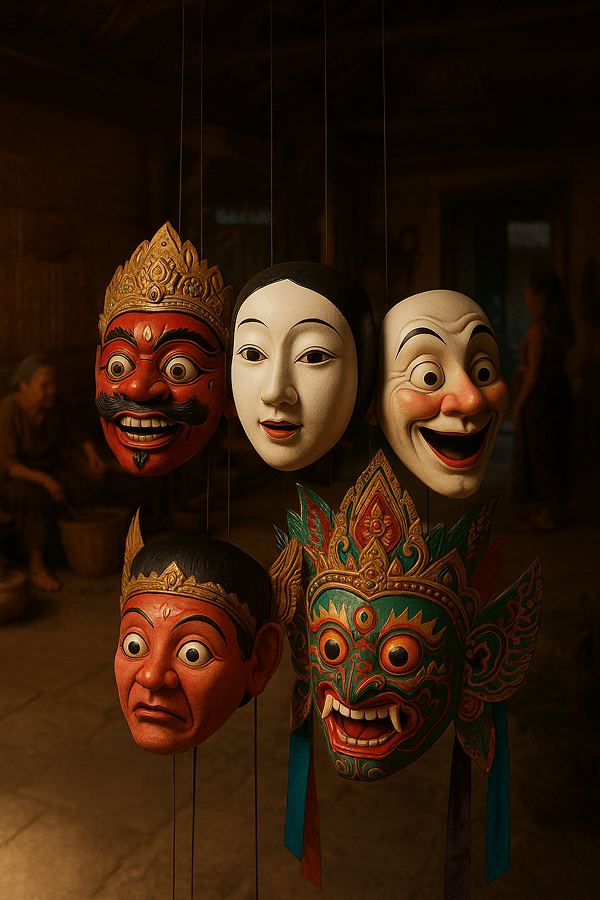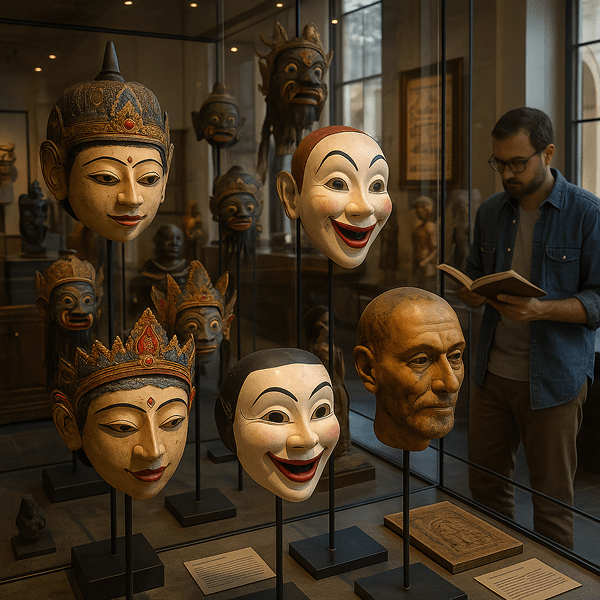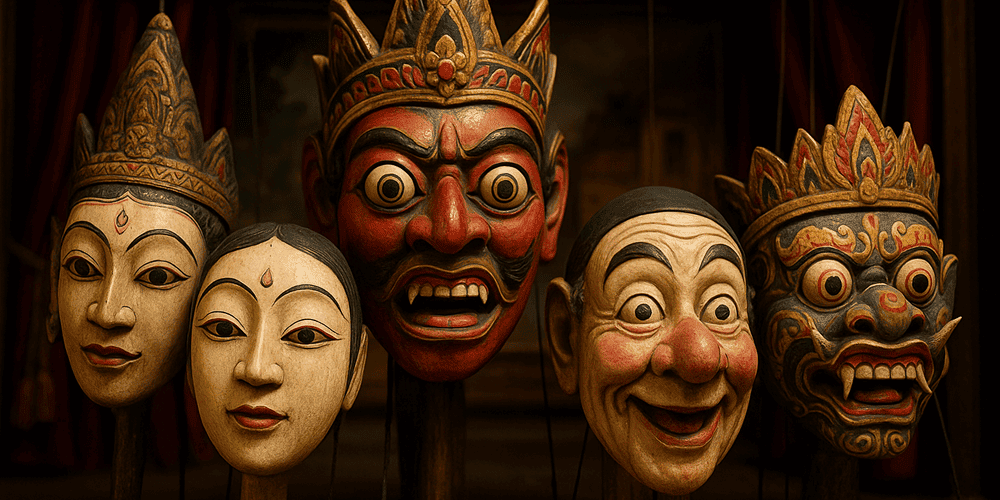Puppet Theatre Masks are a distinctive and integral element of the global puppetry tradition. Unlike wearable masks, Puppet Theatre Masks are crafted to be worn by puppets or marionettes, serving as expressive faces that bring characters to life on stage. These masks are notable for their exaggerated features — large, movable eyes, pronounced mouths, and dramatic eyebrows — all designed to communicate emotion and narrative even from a distance. Colorful and highly stylized, Puppet Theatre Masks may be carved, molded, or painted, often reflecting the folklore, mythology, and social values of their culture of origin. They are present in regional forms from Indonesian wayang golek and Japanese bunraku to the European marionette and shadow puppet traditions. Their roots stretch back centuries, and their visual language continues to evolve in contemporary puppet theatre today.
Historical Origins of Puppet Theatre Masks
The history of Puppet Theatre Masks is as old as puppetry itself, with origins in ancient religious and folk traditions. The word “puppet” derives from the Latin “pupa,” meaning “doll” or “little child,” while “mask” traces back to Latin “masca,” meaning “ghost” or “spirit.” Early puppet masks were used in ritual storytelling and ceremonial performances in Egypt, India, and China, often to embody deities, spirits, or ancestors. By the Middle Ages, puppet theatre flourished across Asia and Europe, with masks evolving alongside theatrical forms. In Java and Bali, wooden masks for wayang golek and wayang kulit shadow puppets gained elaborate, symbolic designs. In Europe, the commedia dell’arte tradition influenced puppet masks, developing archetypal faces for heroes, villains, and fools. Over time, technological advances — such as movable jaws, blinking eyes, or articulated eyebrows — expanded the expressive range of puppet theatre masks. Historical artifacts and documentation, from ancient carvings to Renaissance stage manuals, attest to their enduring presence and evolution. Opera Masks, while originally intended for human actors, have also influenced the design and symbolism of puppet masks in many traditions.
Cultural Significance and Symbolism of Puppet Theatre Masks
Puppet Theatre Masks are imbued with deep cultural and symbolic meaning. In many societies, the puppet mask serves as a bridge between the human and the supernatural, the real and the imaginary. The mask transforms the inert puppet into a living character, allowing it to embody gods, spirits, folklore heroes, or satirical figures. In Asian cultures, specific colors, shapes, and patterns signify character type, virtue, or moral alignment — for instance, red for bravery, white for cunning, black for honesty. Myths and legends often surround famous puppet characters, attributing magical powers or social influence to their masks. Socially, puppet masks transmit traditional stories, critique authority, and teach ethical lessons, often in ways that would be censored in live theatre. Religious and ceremonial contexts may use puppet masks in rituals for fertility, healing, or protection, reinforcing their sacred status within the community.

Materials and Craft Techniques of Puppet Theatre Masks
The making of Puppet Theatre Masks is a specialized craft that varies by region and tradition. Traditional masks are commonly carved from lightweight woods (such as teak or pine), molded from papier-mâché, or cast in clay and painted. Artisans use chisels, knives, and fine brushes to sculpt detailed features; movable parts may be attached with wire, string, or small hinges to enable blinking, talking, or expressive gestures. Decorative elements include natural pigments, gold leaf, fabric, feathers, glass beads, and sequins, with each addition reflecting the puppet’s role and status. Color symbolism is crucial: bold, contrasting colors enhance visibility and emotional impact. Regional differences abound — Javanese wayang golek masks are finely carved and painted, while Japanese bunraku masks are minimalist and emphasize subtlety. European marionette masks often feature comic exaggeration, while shadow puppet masks may be intricately perforated to create striking silhouettes. The process of creating a puppet mask is often collaborative, involving puppet makers, painters, and costume designers.
Functions and Uses of Puppet Theatre Masks
Puppet Theatre Masks serve multiple functions in performance and ritual. On stage, they are central to storytelling, allowing puppets to convey emotion, intention, and character transformation without words. Masks are engineered for maximum expressiveness, often with movable features synchronized to the puppeteer’s gestures and voice. In festivals and parades, large puppet masks may be used to animate giant figures or to interact with audiences. Some traditions use puppet masks in ceremonial contexts, such as harvest rituals or exorcisms, where they are believed to channel protective or healing spirits. Over time, puppet masks have adapted to new media — television, film, and digital animation — while retaining their essential theatrical qualities. In modern productions, masks are sometimes blended with multimedia effects, new materials, or avant-garde design, reflecting the evolving language of puppet theatre.
Regional Variations of Puppet Theatre Masks
Puppet Theatre Masks display remarkable regional diversity. In Indonesia, wayang golek masks are characterized by stylized, elongated faces, while in wayang kulit, flat leather masks are painted and perforated for shadow play. Japanese bunraku uses wooden masks with subtle, minimalist features, while Vietnamese water puppetry employs brightly colored, lacquered masks. Indian kathputli puppetry features expressive faces with intricate painted details. In Europe, Italian commedia dell’arte marionettes have bold, comic masks, while Czech and Slovak puppet traditions favor detailed, lifelike carvings. Each region’s masks reflect local myths, social structures, and artistic values, but all share the goal of bringing stories and characters to life through visual expression. Comparisons with wearable theatrical masks reveal both overlapping symbolism and distinctive traditions.
Famous Examples and Collections of Puppet Theatre Masks
Many of the world’s most celebrated Puppet Theatre Masks are preserved in museums, puppet theaters, and private collections. The Museum Wayang (Jakarta), the International Puppetry Museum (Charleville-Mézières), the National Bunraku Theatre (Osaka), and the Prague National Marionette Theatre all display historic and contemporary masks from their respective traditions. Notable examples include ancient Javanese wayang golek masks, Edo-period Japanese bunraku masks, and 18th-century European marionette heads. Important archaeological finds, such as temple carvings and early stage props, provide insight into the evolution of puppet mask design. Online resources and virtual galleries, such as toddmasks.com, offer high-resolution images, expert analysis, and educational content for a global audience.

Influence of Puppet Theatre Masks on Art and Culture
Puppet Theatre Masks have had a significant influence on visual art, literature, and performance. Their exaggerated forms and symbolic power have inspired painters, sculptors, and filmmakers — most notably in the works of Paul Klee and modern puppet animation. In literature and cinema, puppets and their masks often symbolize hidden identity, social satire, or the struggle between fate and free will. Contemporary designers draw on puppet mask motifs for fashion, jewelry, and stage design, blending tradition with innovation. Puppet masks remain a crucial tool for teaching children, engaging audiences, and preserving oral heritage. The continued celebration of puppet mask traditions plays a vital role in cultural preservation and creative experimentation.
Contemporary Status and Preservation of Puppet Theatre Mask Traditions
Today, Puppet Theatre Masks are both preserved and reinvented by master artisans, theater troupes, and cultural organizations worldwide. Traditional carving and painting techniques are taught in workshops, puppet schools, and masterclasses, while festivals and competitions foster appreciation among new audiences. Modern artists experiment with new materials and technologies — such as 3D printing, animation, and multimedia effects — to expand the expressive potential of puppet theatre masks. Museums, universities, and online platforms like toddmasks.com promote research, documentation, and public engagement, ensuring that the history and artistry of puppet masks remain accessible and relevant. Community-based projects and educational programs help sustain living traditions and foster cross-cultural dialogue.
Collecting and Acquiring Puppet Theatre Masks
The market for Puppet Theatre Masks is rich and varied, with authentic antique pieces, high-quality replicas, and contemporary creations available from puppet makers, galleries, and online platforms. Prices depend on age, craftsmanship, provenance, and artistic merit. Collectors are encouraged to research provenance, seek expert authentication, and prioritize ethical sources that support artists and cultural organizations. Museums and theater companies often offer certified reproductions and educational kits. Toddmasks.com provides resources and guidance for responsible collecting, authentication, and understanding the cultural context of puppet masks. Ethical collecting supports both heritage preservation and the livelihoods of traditional puppet makers.
